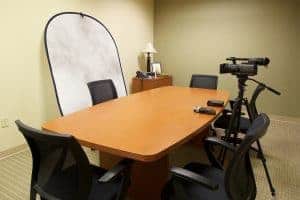By Danny Terry
Video depositions can be beneficial to your case, as they can show the witness’s facial expressions, body language, changes in the inflection of the witness’s tone of voice and pauses before answering. To ensure the best quality video possible, it’s important to consider the layout of the room where your deposition will take place. You’ll want to make certain that all appears proportional, resulting in a much higher quality finished product. In video deposition setups, there are two primary types of camera placement that are used in depositions.
End-to-End Setup
This is the most common setup in a video deposition, where the videographer places the camera, audio mixer and backup video recorder at the far end of the table opposite the witness. The opposing attorneys sit opposite of each other on the left and right sides of the table. The court reporter is placed close to the witness, in between the noticing attorney and the witness.
Pros:
- Witness looks natural and proportional
- Attorneys are on opposite sides of the table, facing each other
- Court reporter has the best view of all parties
- The camera can easily zoom in on the witness and exhibits without causing any distortion
Cons:
- If the table is narrow, objects (laptop screens, water bottles, coffee cups) on the left or right side of the table may appear in the frame of the video
Side-to-Side Setup
Use of the normal end-to-end setup for a videotaped deposition may be hindered by the location of windows or room equipment (TVs, videoconference systems, etc.) In this case, the videographer may need to place the witness on the long side of the table with the camera placed directly across the table from the witness. The court reporter will then be placed next to the witness, across from the camera and attorneys.
Pros:
- Attorneys from both sides of the case are able to look more directly at the witness without needing to turn their heads
- The court reporter has a clear view of each of the attorneys.
Cons:
- Due to the close proximity of the witness to the camera, the witness may appear distorted, especially when leaning towards the camera. The head and arms may appear larger and disproportionate the more they lean in.
- The camera composition will be limited, and it may be difficult to zoom in on any exhibits the witness is holding without causing distortion.



